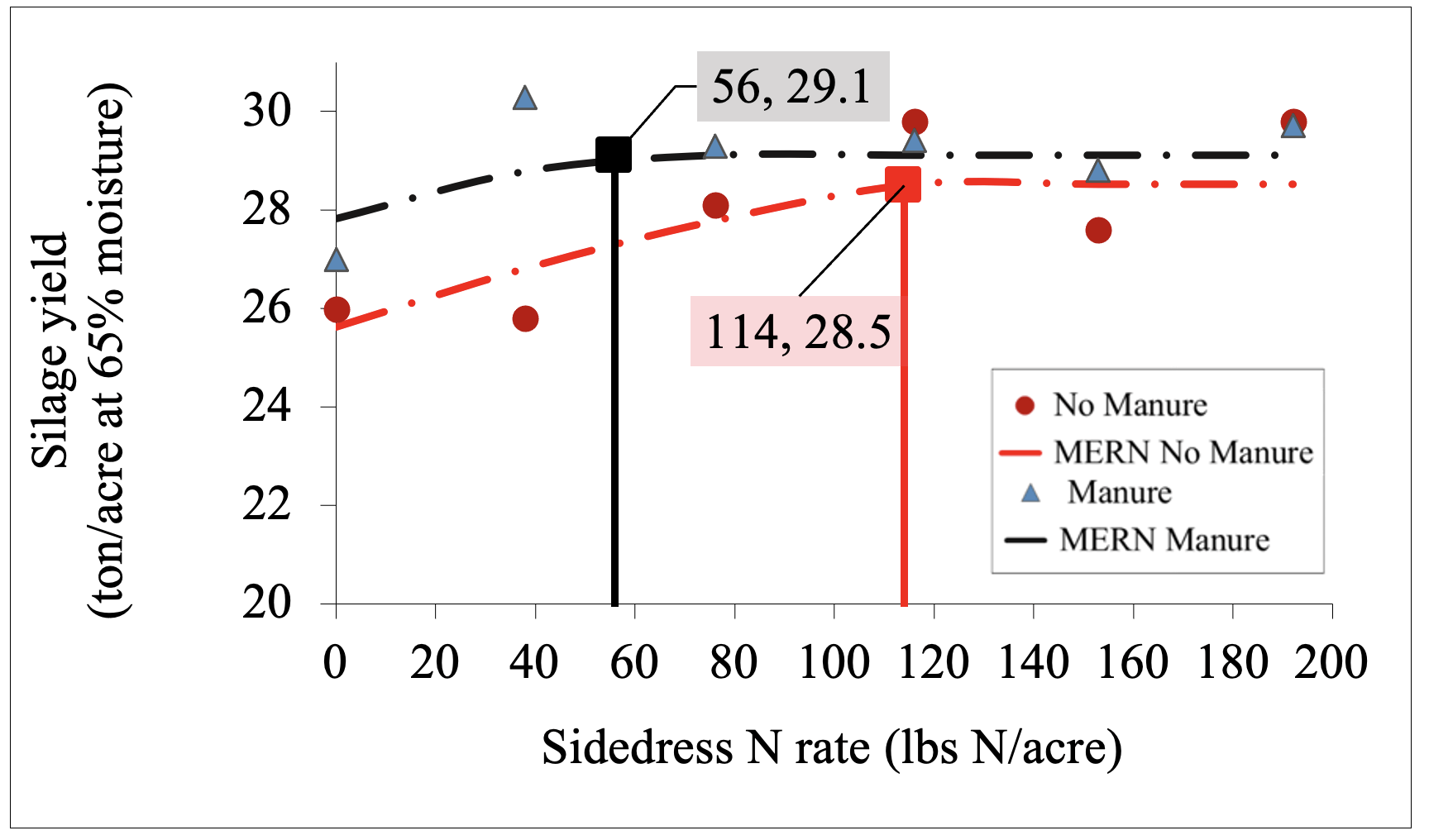Juan Carlos Ramos Tanchez1, Kirsten Workman1,2, Allen Wilder3, Janice Degni4, and Quirine Ketterings1
Cornell University Nutrient Management Spear Program1, PRO-DAIRY2, Miner Agricultural Research Institute3, and Cornell Cooperative Extension4
Introduction
Manure is a tremendously valuable nutrient source. When used appropriately (right rate, right timing, right placement method), it can help build soil organic matter, enhance nutrient cycling, and improve soil health and climate resilience. Sound use of manure nutrients can decrease the need for synthetic fertilizer, thus, lowering whole farm nutrient mass balances and contributing to reduced environmental footprints.
Current guidance for nitrogen (N) credits from manure recognize that N availability depends on the solids content of the manure (lower first year credits for manure with >18% solids than for liquid manure). It also recognizes that the amount of N in manure is affected by how it is collected, stored, treated (solid liquid separated, composted, digested, etc.), and land-applied (timing and method). Higher shares of manure N will be available to crops when manure is applied closer to when crops need it and if manure is injected or incorporated into the soil right after it is applied versus left on the surface.
In the past two decades since manure crediting systems were developed, many different manure treatments technologies have been implemented on farms and re-evaluation of the N crediting system for manure is needed. Furthermore, recent studies have shown that manure can increase yield beyond what could be obtained with N fertilizer only. Thanks to funding from New York Farm Viability Institute (NYFVI) and the Northern New York Agricultural Development Program (NNYADP), we initiated the “Value of Manure” statewide project to evaluate the N and yield benefits of various manure sources and application methods. Three trials were conducted in 2022. Here we summarize the initial findings.
What we did in 2022
Trials were implemented on three farms. Each trial had three strips that received manure and three that did not, for a total of six strips (Figure 1a). Strips were 1200-1800 ft long and 50-80 ft wide. When corn was at the V4-V6 stage, each strip was divided into six sub strips (Figure 1b) and sidedressed at a rate ranging from 0 to up to 192 pounds N/acre, depending on the farm. All three farms applied liquid untreated manure, ranging from 7,525 to 15,000 gallons/acre in the spring.

Soils on farm A were Lima and Honeoye (Soil Management Group [SMG] 2), farm B had a Hogansburg soil (SMG 4), and farm C had Valois and Howard soils (SMG 3). The farms implemented and harvested the trial. The Cornell team sampled for general soil fertility, Pre-Sidedress Nitrate Test (PSNT), Corn Stalk Nitrate Test (CSNT), and silage quality. Each trial was harvested with a yield monitor.
What we have found so far
Corn silage had a different response to manure and inorganic N sidedress in each of the study farms (Figure 2). Farm A responded to both the application of manure and inorganic N fertilizer. In that farm manure application was able to offset 58 lbs N/acre and presented a 0.6 ton/acre yield advantage at the Most Economic Rate of N (MERN), the rate of N that maximizes economic returns, compared to plots with inorganic N fertilizer application only (Figure 3). The application of inorganic N fertilizer and manure had no impact on the yield of farm B, showing that the field already had enough N and did not need any N addition (fertilizer or manure). At farm C, yield did not respond to the application of inorganic N sidedress (the field by itself provided enough N to the crop), but yield was higher when manure was applied: on average manured plots yielded 1.5 ton/acre higher than the no-manure plots. The MERN for farms B and C was 0 lbs N/acre both with manure and without it.
The PSNT and CSNT levels of the manured plots were higher than their no-manure counterparts for all three studies, showing that manure supplied N (Table 1). Both manure and no manure plots in farm A had optimum CSNT levels at the MERN, showing that manure was able to offset 58 lbs N/acre.


Conclusions and Implications (and Invitation)
The trials of 2022 show the range of possible responses, with one trial not showing a yield or N benefit of the manure, one trial showing a yield increase when manure was applied that was not due to N addition, and one showing both a yield and N fertilizer benefit from manure. This shows the importance of targeting manure application to fields with low past N credits, where it will be most likely to cause a yield respond. Additional trials are needed with various manure sources (raw manure, separated liquids, solids, digestate, etc.) before we can draw conclusions about the N and yield benefits of manure. Join us for the 2023 Value of Manure project and obtain valuable insights about the use of manure in your farm! If you are interested in joining the project, contact Juan Carlos Ramos Tanchez at jr2343@cornell.edu.
Additional Resources
The NMSP Value of Manure Project website and on-farm field trial protocols are accessible at: http://nmsp.cals.cornell.edu/NYOnFarmResearchPartnership/Value_of_Manure.html (website) and http://nmsp.cals.cornell.edu/NYOnFarmResearchPartnership/Protocols/NMSP_Value_of_Manure_Protocol2023.pdf (protocol).
Acknowledgments
We thank the farms participating in the project for their help in establishing and maintaining each trial location, and for providing valuable feedback on the findings. For questions about this project, contact Quirine M. Ketterings at 607-255-3061 or qmk2@cornell.edu, and/or visit the Cornell Nutrient Management Spear Program website at: http://nmsp.cals.cornell.edu/.





